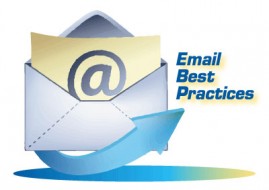Careless Keystrokes & Bad Decisions: New York Law on Inadvertent Disclosure (Part 1)
By Robert A. Barrer
inadvertent
adjective: in·ad·ver·tent \-tənt\
Merriam-Webster definition: not intended or planned
The word “inadvertent” conjures in most lawyers a distressing feeling that they have done something wrong and that the consequences for their clients (and the lawyers themselves) are not going to be good. Chances are this bad feeling is well-placed because it is difficult to imagine that a lawyer who does something “inadvertently” is going to be rewarded.
For New York lawyers, April 1, 2009 is significant because it marks the date that the Rules of Professional Conduct (RPC) formally replaced the Code of Professional Responsibility and brought with it RPC 4.4(b). In a mere 31 words, the Rule imposed upon lawyers who received inadvertently disclosed information, even if clearly protected by attorney-client privilege, one obligation, and only one: Notify the sender.
RPC 4.4(b) imposes no obligation to refrain from reviewing the information or even to return it to the sender. As discussed below, there are other rules, ethics opinions, reported decisions and principles of civility and cordiality that may impose those obligations. However, a New York lawyer who complies with the “notify the sender” requirement of RPC 4.4(b) should not face discipline for reviewing and retaining the information.
This article will discuss all the ramifications of inadvertent disclosure in New York as addressed in the RPCs and civil statutes and rules. We have divided the article into two parts. In Part 1, we will define what we mean by “inadvertent disclosure,” and discuss how lawyers faced with this problem should conduct themselves under RPC 4.4(b) and the ethics opinions interpreting it. In Part 2, to be published next month, we discuss court decisions regarding this issue, and the uneasy tension between those decisions, which tend to place greater restrictions on lawyers receiving inadvertently produced privileged documents, and the more permissive RPC 4.4(b).
Examples of Inadvertent Disclosure of Privileged Information
♦ It is 5:05 p.m. and you receive a panicked phone call from the secretary of a lawyer at a law firm representing an adverse party. The secretary tells you that she mistakenly sent a four-page fax to your fax number that was meant for the client of the other law firm (you have not yet seen the document). You are told by the secretary that the document is highly confidential and that if her boss finds out, she will be fired. She begs you to rip up the pages without reading them and asks you to promise not to say anything about it to anyone. Do you want to be responsible for someone getting fired?
♦ You receive an envelope from the law firm representing an adverse party. As you open the envelope and pull out the enclosure, you see that it is an original letter from opposing counsel to the adverse party that was obviously put in the wrong envelope. Do you read the letter?
♦ Opposing counsel sends you an email message with a settlement proposal. Ten minutes later, you receive an additional email message on the same subject. When you open the second message, you see that it is a message from the adverse party to opposing counsel with lengthy comments about the settlement proposal together with an attachment with a title “Confidential Settlement Strategy.” The client of opposing counsel obviously received the message as a “bcc” and hit the dreaded “Reply to All” button. Do you read the message and the attachment?
♦ You receive an email message from opposing counsel with the subject line referring to a current engagement. Your name is Robert Barrer. When you open the message, you see that it is really directed to Richard Barber whom you know is the General Counsel of the adverse party. This message was obviously not meant for you and you rightfully suspect that opposing counsel allowed Microsoft Outlook® to “autofill” names and never bothered to check before hitting the “Send” button. Do you read the message?
♦ You represent the seller in a business transaction and have been trading drafts of the agreement back and forth with the attorney for the buyer for several weeks. An email is sent to you by the buyer’s attorney that contains a copy of the agreement in Microsoft Word® format. When you open the document, there are multiple “red line” changes and embedded comments. This is how you have been dealing with changes to the document. When you place your cursor over the first embedded comment, it reads “you are authorized to offer as much as $2.6M for this business, but I would really like to keep our present offer of $1.7M for a little while longer to see if we can get some additional movement in our direction.” You now realize that the comment was not made by the opposing counsel, but instead was made by the buyer herself. Opposing counsel either forgot to remove the comment or did not realize it was even there. Do you keep reading and look for the next embedded comment? Do you tell your client that the opposing party is willing to pay $2.6M and to reject the $1.7M offer? See, e.g., Young v. Utica First Ins. Co., 2013 N.Y. Misc. LEXIS 298 (Sup. Ct., N.Y. County Jan. 22, 2013) (in an action to enforce a consent judgment for $950K, there is an inadvertent disclosure of a lawyer’s recommendation to the client to accept $350K).
Text of New York RPC 4.4(b)
A lawyer who receives a document relating to the representation of the lawyer’s client and knows or reasonably should know that the document was inadvertently sent shall promptly notify the sender.
Notify the sender. That’s it. Period. This mandate seems straightforward, but it only represents the beginning of the inquiry for any lawyer who receives inadvertently disclosed information. What inquiries should be made?
First, what is a document? The word “document” is not listed in the definitions in RPC 1.1. However, it should be read to include digital and electronic information. See Comment 2 to RPC 4.4(b) (referencing the term “writing” which includes email and discussing electronically stored information); Roy D. Simon and Nicole Hyland, Simon’s New York Rules of Professional Conduct, RPC 4.4(b) at pp. 1350–1351 (2016 Ed.) (discussing proposed amendment to RPC 4.4(b) to add “electronically stored information or other writing” to the text of the Rule.
Second, was the transmission inadvertent? If it was sent deliberately by someone who wanted the lawyer to receive the information, it was not an inadvertent disclosure. How could this occur? Your client is involved in a bitter divorce and hacks into the spouse’s email account and forwards the spouse’s privileged communication with opposing counsel. Tread cautiously here, because N.Y. State Bar Assn. Comm. on Prof. Ethics Formal Op. 945 (2012) prohibits disclosure of this type of client communication unless the lawyer knows that the client is committing a crime or fraud and no other remedial measures will prevent harm to the opposing party or applicable precedent compels disclosure. But the main point is that, at least by its terms, RPC 4.4(b) does not apply to the receipt of such intentionally stolen information.
Third, was the transmission a knowing waiver by the sending lawyer of a privilege that may otherwise exist? If the transmission was part of a document disclosure that could arguably be relevant to the claims or defenses in an action or proceeding, there are circumstances where a waiver will be found to have occurred. See, e.g., SEC v. Cassano, 189 F.R.D. 83, 86 (S.D.N.Y. 1999) (determining that inadvertent disclosure of specific privileged document which attorney had been warned to protect constituted waiver); Lois Sportswear, U.S.A., Inc. v. Levi Strauss & Co., 104 F.R.D. 103, 105 (S.D.N.Y. 1985) (analyzing whether inadvertent production constituted a waiver, and concluding that “Levi only just adequately protected its privilege”).
Fourth, was the receipt of the inadvertently disclosed information related to the representation of a client? If not, there may be no obligation to do anything. How could this occur? Suppose that the sender is a lawyer representing a client who intends to bring a claim against the lawyer who receives the transmission. Some courts outside of New York have taken the position that a lawyer who receives such a transmission is not representing a client and therefore receives the information in the lawyer’s individual capacity. See Ellen J. Bennett, Elizabeth J. Cohen & Helen W. Gunnarsson, Annotated Model Rules of Professional Conduct, p. 471 (ABA Center for Prof. Responsibility 8th Ed. 2015) (collecting cases).
Fifth, do you want to be known in the legal community in which you practice as the kind of attorney who takes advantage of other people’s mistakes? The way in which you respond to this type of situation can have a lasting impact on your reputation. See generally James M. Altman, Inadvertent Disclosure and Rule 4.4(b)’s Erosion of Attorney Professionalism, N.Y. State Bar Assn. Journal (November/December 2010); RPC 1.2(g) (“A lawyer does not violate these Rules by … treating with courtesy and consideration all persons involved in the legal process.”).
New York Ethics Opinions
N.Y. State Bar Assn. Comm. on Prof. Ethics Formal Op. 945 (2012) addresses what apparently is becoming less of an unusual situation in matrimonial practice, i.e., when Spouse 1 intercepts the attorney-client email communication of Spouse 2. May Spouse 1’s lawyer disclose this fact to the court? According to NYSBA Op. 945 the answer is “no,” unless the lawyer knows that the client is committing a crime or fraud and no other remedial measures will prevent harm to the opposing party or applicable judicial precedent mandates disclosure. Must Spouse 1’s lawyer follow RPC 4.4(b) and notify Spouse 2’s lawyer that these confidential communications have been intercepted? Perhaps not because the communication was deliberately provided. What should the receiving lawyer do? At a minimum, caution the client to stop this practice and refrain from copying, further transmitting or using the communications.
Formal Op. 945 provides additional guidance on how to respond and the circumstances under which disclosure may be appropriate, and also makes clear that lawyers in this situation must follow the applicable discovery rules, which actively discourage litigants from surreptitiously obtaining documents from the opposing party. One scenario not specifically covered by Formal Op. 945 involves the situation Spouse 1 not only intercepts the confidential communications, but also provides them to Spouse 1’s lawyer. Once the lawyer is in possession of “stolen” information, there may be other obligations including the prohibition against permitting a client to perpetrate a fraud upon a tribunal (RPC 3.3 and 3.4), the prohibition against violating the rights of a third person (RPC 4.4(a)) and the prohibition against engaging in improper conduct including that which is prejudicial to the administration of justice (RPC 8.4).
With respect to the example discussed above regarding embedded comments in a document, New York lawyers are obligated to exercise reasonable care to prevent disclosure of confidences and secrets contained in “metadata” in documents that they transmit electronically to opposing counsel or other third parties. See NYSBA Comm. on Prof. Ethics Formal Op. 782 (2004); N.Y. County Lawyer’s Assn. Comm. on Prof. Ethics Op. 738 (2008). It is similarly improper for New York lawyers to employ technology to surreptitiously examine and trace e-mail or “mine” into documents for hidden information such as comments and track changes. See NYSBA Comm. on Prof. Ethics Formal Op. 749 (2001); N.Y. County Lawyer’s Assn. Comm. on Prof. Ethics Op. 738 (2008).
If the receiving attorney believes in good faith that the communication may be retained and used, the receiving attorney may, subject to certain conditions, submit the communication for in camera consideration by a tribunal. Assn. of the Bar of the City of New York Comm. on Prof. & Jud. Ethics Formal Op. 2003-4 (2003). Where the receiving attorney has been exposed to the content of the communication prior to knowing or having reason to know that the communication was misdirected, the receiving attorney is not barred from using the communication. However, the receiving attorney must notify the sending attorney and permit the sending attorney to promptly take whatever steps the sending attorney feels are necessary to prevent any further disclosure. Id.
The conclusion reached in the opinion cited above was withdrawn in 2012 by NYCBA Formal Op. 2012-1 (2012). Although Formal Op. 2012-1 merely tracks RPC 4.4(b) in referring to the “notify the sender” requirement, the opinion noted that there may be circumstances in which a lawyer may choose to act in conformity with the guidance in Formal Op. 2003-04 without thereby per se violating Rule 4.4(b). For a history of the law in New York prior to RPC 4.4(b), see R. Barrer, Unintended Consequences, Avoiding and Addressing the Inadvertent Disclosure of Documents, N.Y. State Bar Assn. Journal (November/December 2005).
ABA Ethics Opinions
ABA Formal Opinion 11-460 (Aug. 4, 2011) deals with the dilemma when an employer’s lawyer receives copies of an employee’s private communications with counsel (found on the employee’s workplace computer or other device). The opinion explains that neither Rule 4.4(b) nor any other Rule requires the employer’s lawyer to notify opposing counsel of the receipt of the communications. Court decisions, civil procedure rules, or other law may impose such a notification duty, which a lawyer may then be subject to discipline for violating. For example, decisions such as Scott v. Beth Israel Med. Ctr. Inc., 17 Misc. 3d 934, 847 N.Y.S.2d 436 (Sup. Ct., N.Y. County 2007) and In Re Asia Global Crossing, Ltd., 322 B.R. 247 (Bankr. S.D.N.Y. 2005), depending on whether an employer has a formal email policy and what it says, may lead to the conclusion that the attorney-client privilege has been waived. If the law governing potential disclosure is unclear, Rule 1.6(b)(6) allows the employer’s lawyer to disclose that the employer has retrieved the employee’s attorney-client e-mail communications to the extent the lawyer reasonably believes it is necessary to do so to comply with the relevant law. If no law can reasonably be read as establishing a notification obligation, however, then the decision whether to give notice must be made by the employer-client, and the employer’s lawyer must explain the implications of disclosure, and the available alternatives, as necessary to enable the employer to make an informed decision. See RPC 1.4 (discussing the obligation to promptly communicate important developments with clients).
ABA Formal Opinion 06-442 (Aug. 5, 2006) addresses access to and use of embedded data. As recognized in the opinion, the Model Rules of Professional Conduct do not contain any specific prohibition against a lawyer’s reviewing and using embedded information in electronic documents, whether received from opposing counsel, an adverse party, or an agent of an adverse party. A lawyer who is concerned about the possibility of sending, producing, or providing to opposing counsel a document that contains or might contain metadata, or who wishes to take some action to reduce or remove the potentially harmful consequences of its dissemination, may be able to limit the likelihood of its transmission by “scrubbing” metadata from documents (using readily available computer programs) or by sending a different version of the document without the embedded information.
According to ABA Formal Opinion 06-440 (May 13, 2006), a lawyer who receives privileged materials that the lawyer knows were not the result of the sender’s inadvertence (e.g., purloined documents from a third-party) is not required to notify another party or that party’s lawyer of receipt under Model Rule 4.4(b) and is not required to refrain from reading the materials. Whether substantive law imposes other obligations on the lawyer is beyond the Rule’s dictates. ABA Formal Opinion 06-440 withdrew an earlier opinion, Formal Opinion No. 94-382, that reached the opposite conclusion. ABA Formal Opinion 05-437 (Oct. 1, 2005) discusses professional responsibility concerns when a lawyer receives a document from opposing parties or their lawyers and knows or reasonably should know that the document was inadvertently sent. The opinion instructs lawyers to promptly notify the sender in order to permit the sender to take protective measures. The opinion notes that the rule does not require the receiving lawyer either to refrain from examining the materials or to abide by the instructions of the sending lawyer. As a consequence, ABA Formal Opinion 92-368, which came to the opposite conclusion, was withdrawn.
Having now explored the text and interpretations of RPC 4.4(b), we can see that the ethical burden has shifted from the recipient, who once had to stop reading immediately and follow the sender’s instructions, to the sender, who now has to exercise great care or risk having opposing counsel read its privileged communications with impunity.
Next month, in Part 2 of this article, we will discuss how the recipient lawyer’s obligations under RPC 4.4(b) compare and contrast with those under the civil discovery rules. We will also provide detailed guidelines as to how lawyers should respond when confronted with this problem, either as senders or recipients.
Robert Barrer is the Chief Ethics and Risk Management Partner at Barclay Damon, LLP and is responsible for all ethics, conflicts and loss prevention activities at the firm. He counsels firm attorneys and provides analysis and advice on, among other things, ethical questions involving conflicts of interest, privileges, and legal issues arising under the Rules of Professional Conduct. He also supervises the firm’s continuing legal education programs and lectures on a wide variety of ethics and practice management topics. Mr. Barrer can be reached at (315) 425-2704 or rbarrer@barclaydamon.com.
Get CLE Credit for this month’s articles (March 2016).
DISCLAIMER: This article provides general coverage of its subject area and is presented to the reader for informational purposes only with the understanding that the laws governing legal ethics and professional responsibility are always changing. The information in this article is not a substitute for legal advice and may not be suitable in a particular situation. Consult your attorney for legal advice. New York Legal Ethics Reporter provides this article with the understanding that neither New York Legal Ethics Reporter LLC, nor Frankfurt Kurnit Klein & Selz, nor Hofstra University, nor their representatives, nor any of the authors are engaged herein in rendering legal advice. New York Legal Ethics Reporter LLC, Frankfurt Kurnit Klein & Selz, Hofstra University, their representatives, and the authors shall not be liable for any damages resulting from any error, inaccuracy, or omission.
Related Posts
« Masking Tapes: An Analysis of the Law of Secret Recording in New York Recent N.Y. Ethics Opinions: May 2016 »









